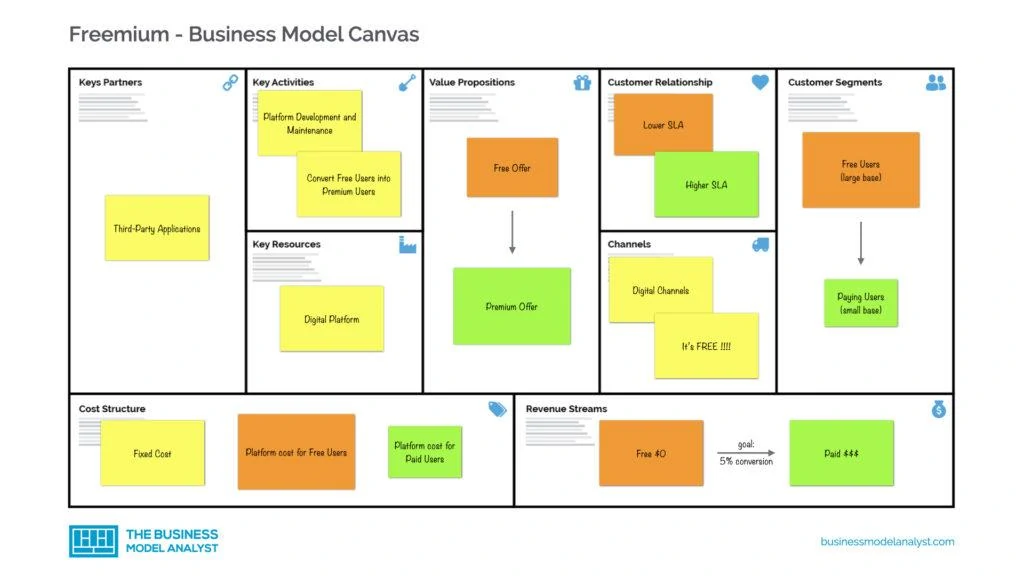If you study internet business models you have probably heard of the freemium business model. If you made the association of the expression “freemium” with the words free and premium, you thought it right! Simply put, freemium is a business model in which the vast majority of users will use your product for free and a small portion will pay for it. But how does it work, after all? Let’s take a closer look.
Contents
What is the Freemium Business Model?
Freemium is a business model in which you offer a basic plan, product or service, with few resources, completely free, for users to know about it. At the same time, you offer another more complete plan, more advanced service or additional features in exchange for a fee – the premium option. The freemium business model is often identified as the “business model of the Internet.” That is because, on the worldwide web, it is common to use the strategy of offering something for free, with a small customer acquisition cost, but potential sales growth in the long run. The goal is to attract consumers, create a customer base to convince further part of that base that you have a more compelling value proposition than the free one, whose advanced features are worth the investment. It is important to note, however, that freemium is not the same thing as a business model that offers a free sample or free trial. The freemium model does not stop offering the free option. It just differentiates the added value between that and the premium version. A good example is when you use, for example, a cloud storage platform, which offers you certain storage space in the free version and a much larger one in the premium version. Or, games and apps with free versions full of ads, which will stop appearing if you decide to pay a monthly fee. The great success factor of the freemium business model is the variation of its value proposition from one version to the other. Therefore, first, it is important to design both proposals carefully, so that both products are desirable. Second, it is essential to calculate what ratio between free and premium options is necessary to make your business financially healthy.
Freemium Business Model Canvas
Let’s take a look at the Business Model Canvas of the Freemium Pattern

Freemium business model benefits
One of the facilities of the freemium model is marketing. This is because offering a product or service for free is always a very effective way to attract customers, and, besides, this strategy works very well on the internet, where the acquisition cost is very low. Finally, even if free users do not pay, the chance that they will spread the news to their acquaintances is great, providing wide word of mouth. The other positive point is network effects. Within this concept, the more people use a particular product or service, the more valuable it becomes. A social network, for example, will never be a network if there are no people to connect with. And offering something free is one of the simplest ways to build an audience and, thus, foster the network effect.
Freemium business model risks
One of the difficulties with the freemium model is that you need to get a lot of free users – a real lot of them, we’re talking about millions. Because, maybe, about only 1% will buy the premium offer (the industry benchmark is 5% – but that’s really hard to achieve). That is, if your product or service is aimed at a specific niche, it is better to go straight to the premium business model. Another point to focus your attention on is that the value of your service needs to increase over time for your audience. There is no point in acquiring new customers if you are unable to retain them. And in general, people only buy the premium option after a period of use. It is also essential that you keep your cost structure lean. Because the freemium model takes a long time to be profitable, therefore, your revenue per user must be much higher than your cost per user.
Some Freemium Examples

Skype
The application that allows you to make calls via the internet has more than 600 million free users. And a small portion of them pays to be able to make calls to regular phone lines. But this “small portion” accounts for more than a billion in revenue.
The famous professional social network has more than 500 million registered users, with at least half active monthly. Subscribers pay nothing, but some service options are charged, such as ads from recruiters and companies.
Spotify
The music streaming service is an example of a successful freemium model. The platform has about 268 million active users, and, of these, more than 130 million are premium accounts. That is, almost half of the users pay for the service!
Evernote
The app records and saves everything you want to write down and remember. There comes a time when you already have so much stuff saved inside that you agree to pay, so you can have more space and not lose everything that was already there.
MailChimp
MailChimp started with the premium business model and, a while later, decided to try to make a change to freemium. Result: paying users grew 150% – and profit, 650%. It is a free newsletter service, which is paid when you reach a certain number of e-mails on your list, or if you want to send them to more people than the free option allows.

One of the advantages that companies, products and services based on the internet have, is precisely the possibility of running market tests, which includes experimenting with different business models, to see which one can work best. Just as there are cases like MailChimp, which started premium and worked very well by migrating to freemium, there are others, like Dropbox, which reversed the order, leaving freemium to direct premium. Today, Dropbox only offers a free 30-day trial. The important thing is to know the advantages and disadvantages of each model, study them very well and, when possible, run tests to see which is the most suitable for each business.


